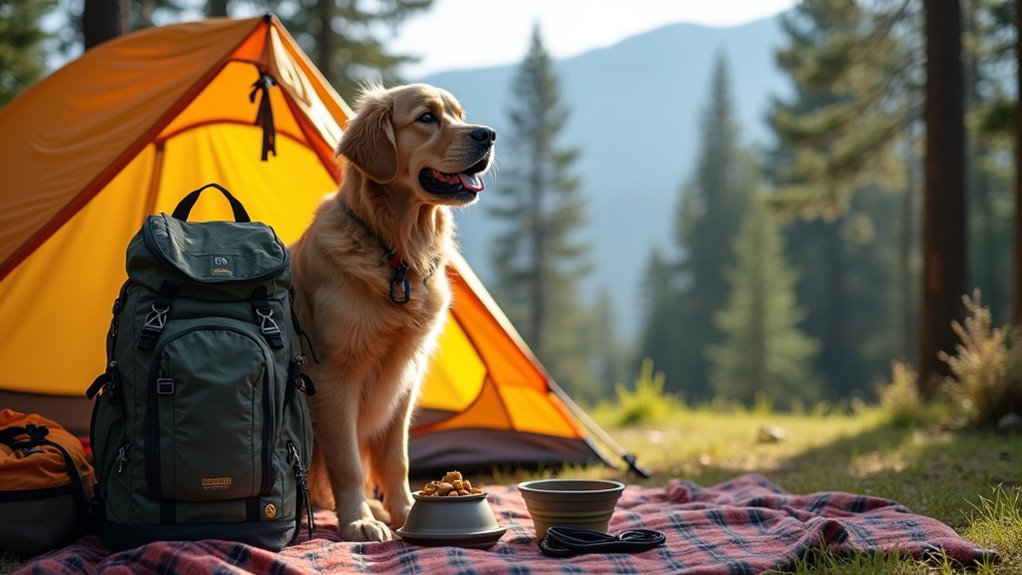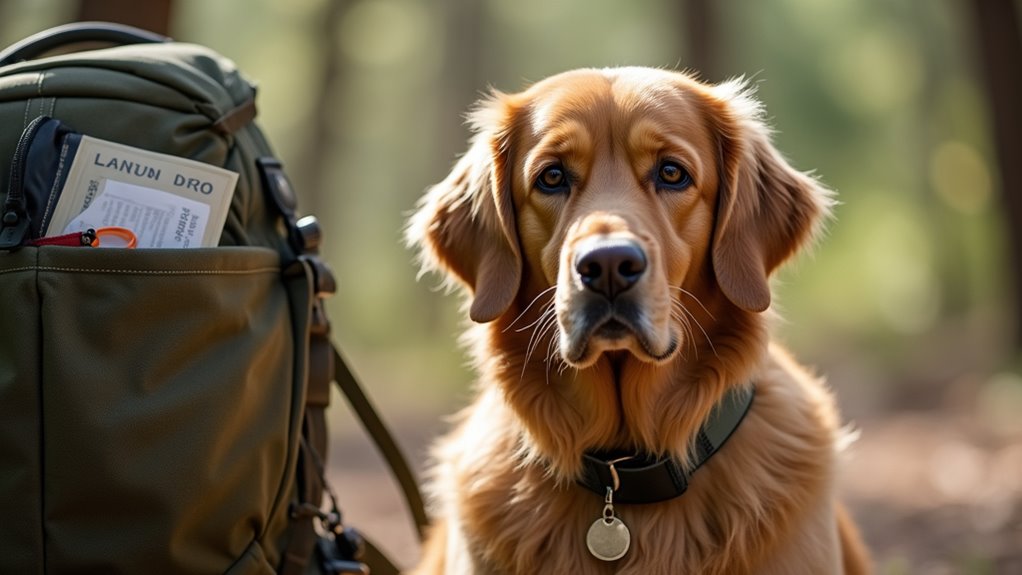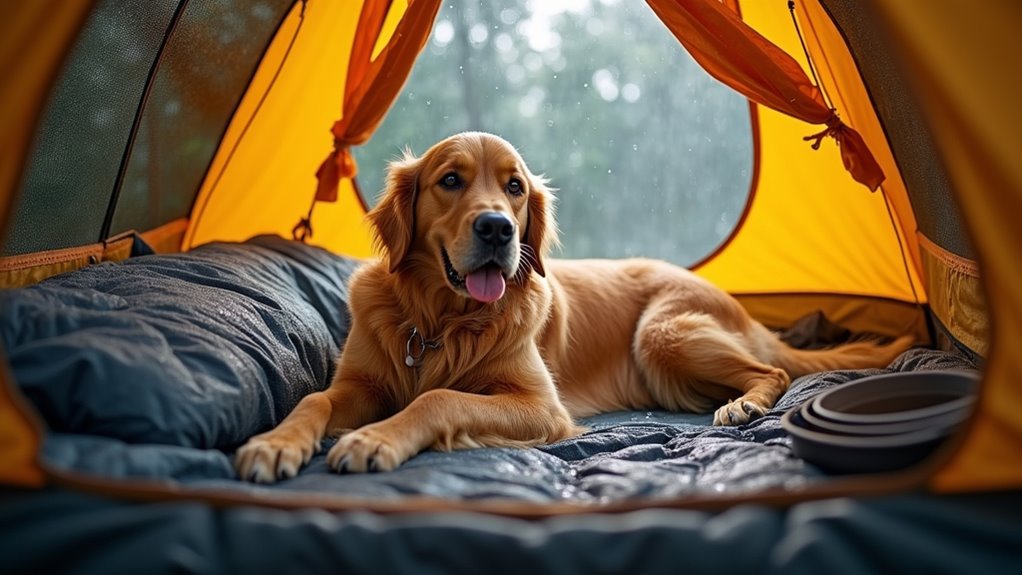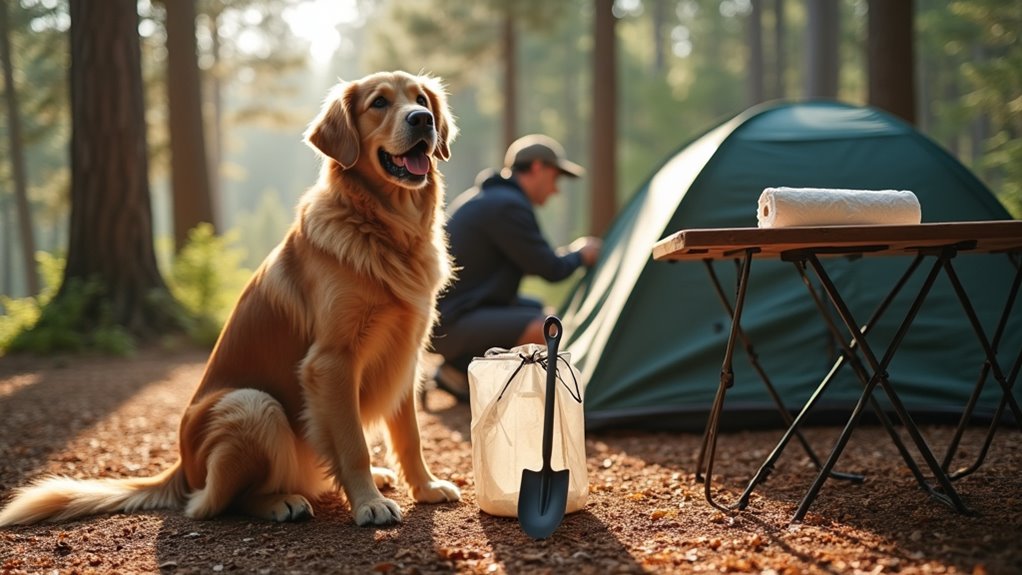Physical Address
304 North Cardinal St.
Dorchester Center, MA 02124
Physical Address
304 North Cardinal St.
Dorchester Center, MA 02124

Master these essential dog camping strategies to avoid dangerous mistakes that could ruin your outdoor adventure completely.
You’ve probably heard that camping with your dog creates the perfect bonding experience, but the reality isn’t always so idyllic. Without proper preparation, your outdoor adventure can quickly turn into a stressful ordeal for both you and your furry companion. From unexpected wildlife encounters to forgotten essentials, there’s much more to weigh up than simply packing an extra sleeping bag. The difference between a memorable trip and a disaster often comes down to knowing these critical preparation strategies.

Before you pack a single item or leash up your furry companion, you’ll need to verify that your chosen destination actually welcomes four-legged campers. Many campgrounds have strict no-pet policies, while others charge additional fees or restrict dogs to specific areas.
Start by checking the campground’s official website or calling directly to confirm their pet policy. Ask about leash requirements, designated dog areas, and any breed restrictions.
Don’t forget to research trail regulations too—some hiking paths prohibit dogs entirely, especially in sensitive wildlife areas or national parks.
Download relevant apps like Campendium or BringFido to locate dog-friendly spots. Always carry proof of current vaccinations and rabies certificates, as many facilities require documentation.
Consider renting an RV for your camping adventure, as this provides your dog with a familiar, climate-controlled space to retreat to after outdoor activities.
This upfront research prevents disappointing surprises and ensures you’ll find welcoming spaces for both you and your canine companion.
Once you’ve confirmed your destination welcomes dogs, it’s time to assemble the gear that’ll keep your pup comfortable and safe throughout your adventure. Start with the basics: extra food, collapsible water bowls, and plenty of fresh water.
Essential gear preparation ensures your dog’s comfort and safety during outdoor adventures, starting with basic necessities like extra food and collapsible water bowls.
Pack a first aid kit specifically for dogs, including bandages, antiseptic wipes, and any medications your pet needs. Don’t forget waste bags – you’ll need more than you think.
A sturdy leash, backup collar with ID tags, and a comfortable sleeping pad or blanket are essential. Consider booties to protect paws from rough terrain, and pack familiar toys to help reduce anxiety.
Finally, bring grooming supplies to remove burrs, dirt, and debris after hikes. Remember that practicing proper camping etiquette with your dog ensures everyone at the campground can enjoy their outdoor experience.

While gear keeps your dog comfortable, proper identification and health documentation protect them from getting lost or turned away at checkpoints. You’ll need current vaccination records and identification before hitting the trail.
Essential documentation includes:
Double-check expiration dates on all vaccines, especially rabies, as many campgrounds won’t accept expired documentation.
Keep physical copies in waterproof bags and store digital backups on your phone.
Contact your destination ahead of time to confirm their specific health requirements and documentation policies.
If you’re planning to explore more challenging terrain with your dog, consider that some glacier climbing trails may have additional permit requirements or restrictions for pets.
Having the right paperwork gets you to the campground, but your dog’s behavior determines how enjoyable the experience will be for everyone involved. Practice essential outdoor commands like “stay,” “come,” and “leave it” before your trip. These commands become vital when your dog encounters wildlife, other campers, or tempting food scraps around campsites.
Perfect your dog’s leash etiquette through regular walks in varying environments. Your dog should walk beside you without pulling, especially on narrow trails where space is limited. Train them to respond immediately when you stop or change direction.
Work on the “quiet” command to prevent excessive barking that disturbs other campers. Practice these skills in your backyard first, then gradually introduce distractions. Consider bringing house pets other than dogs if they’re well-trained and the campground allows multiple pet types. Consistent training ensures your camping adventure remains peaceful for everyone.

Dogs can’t regulate their body temperature as effectively as humans, so you’ll need to prepare for weather extremes that could make your furry companion uncomfortable or even put them at risk.
Pack appropriate gear based on expected conditions. For hot weather, bring cooling mats, portable shade structures, and plenty of water. In cold conditions, pack insulated dog blankets, booties for paw protection, and a weatherproof jacket for short-haired breeds.
Essential weather protection items include:
Monitor your dog constantly for signs of overheating or hypothermia, and adjust your camping plans accordingly. While keeping your dog safe and comfortable, don’t forget to plan some fun camping activities that you can both enjoy together during your outdoor adventure.
After securing weather protection, you’ll need to establish a dedicated sleeping space that keeps your dog comfortable and contained throughout the night. Choose a flat, debris-free area away from your campfire and cooking zone.
Bring your dog’s familiar blanket or bed to provide comfort and scent recognition in the unfamiliar environment.
Set up a portable dog crate or use a long tether system if your pet isn’t crate-trained. This prevents nighttime wandering that could lead to encounters with wildlife or getting lost.
Position the sleeping area close enough to your tent so you can hear any distress signals.
Check the ground for sharp rocks, thorns, or harmful plants before settling in.
Consider bringing an elevated dog bed to keep your pet off cold or damp ground.
You can find discount camping gear for your pet’s sleeping setup by shopping online, where retailers often offer competitive prices on portable dog beds and travel crates.

Proper food storage becomes even more important when camping with your dog than when you’re camping alone. Your pet’s keen sense of smell can attract wildlife, creating dangerous situations for everyone involved. You’ll need to secure both human and dog food in bear-proof containers or hang them at least 12 feet high and 4 feet from tree trunks.
Dogs’ powerful noses can lure dangerous wildlife to your campsite, making proper food storage absolutely critical for everyone’s safety.
Maintain your dog’s regular feeding schedule to prevent anxiety and digestive issues. Here’s what you should prioritize:
Don’t let your dog scavenge around the campsite, as this encourages wildlife visits. Remember that safe food storage principles apply to all camping situations, whether you’re with pets or not.
When you’re camping with your dog, wildlife encounters pose serious risks that require advance preparation and constant vigilance. Research the area’s specific wildlife beforehand—bears, coyotes, snakes, and other predators behave differently and require tailored precautions.
Keep your dog leashed at all times to prevent them from chasing or confronting wild animals. Store scented items like dog food, treats, and waste in bear-proof containers or hang them properly.
Watch for environmental hazards like poisonous plants, steep cliffs, fast-moving water, and extreme temperatures. Pack a first-aid kit for both you and your dog, including tweezers for removing thorns or splinters.
Carry bear spray if you’re in bear country, and know how to use it effectively. Stay alert during dawn and dusk when wildlife activity peaks. In hot weather conditions, ensure your dog has adequate shade and water to prevent overheating and heat-related emergencies.

Since your dog’s waste attracts wildlife and creates health hazards, you’ll need to pack out every trace of it during your camping trip. Proper waste management protects the environment and keeps your campsite safe for everyone.
Always bring biodegradable bags and dispose of waste in designated trash receptacles. If none exist, pack it out with your regular garbage. Don’t bury dog waste, as it contaminates water sources and soil.
Keep your dog’s sleeping area tidy and wash any muddy paws before entering your tent. Plus, maintaining a clean campsite helps reduce mosquito breeding grounds, as these insects are attracted to standing water and organic debris that can accumulate around your camping area.
While camping environments can overwhelm even well-traveled dogs, you’ll spot potential problems early by watching for subtle changes in behavior and physical condition. Check your dog’s paws daily for cuts, thorns, or excessive wear from rough terrain.
Watch for signs of dehydration like sticky gums, lethargy, or reduced urination. Monitor eating habits—sudden appetite loss often signals stress or illness.
Behavioral changes matter too. Excessive panting, restlessness, hiding, or unusual aggression indicate your dog’s struggling with the new environment. Some dogs pace constantly when anxious, while others become unusually clingy or withdrawn.
Create quiet retreat spaces where your dog can decompress. If stress signs persist despite your efforts, consider cutting the trip short—your dog’s wellbeing trumps camping plans. Consider whether renting a boat for water-based activities might be less stressful than committing to unfamiliar boating situations during your camping adventure.
You’re now absolutely prepared to conquer the wilderness with your four-legged adventure buddy! Don’t let a single detail slip through the cracks – your dog’s counting on you to be their ultimate outdoor superhero. Keep these game-changing tips burned into your memory, and you’ll create the most epic camping memories that’ll have your pup’s tail wagging for months. Get out there and make it happen!